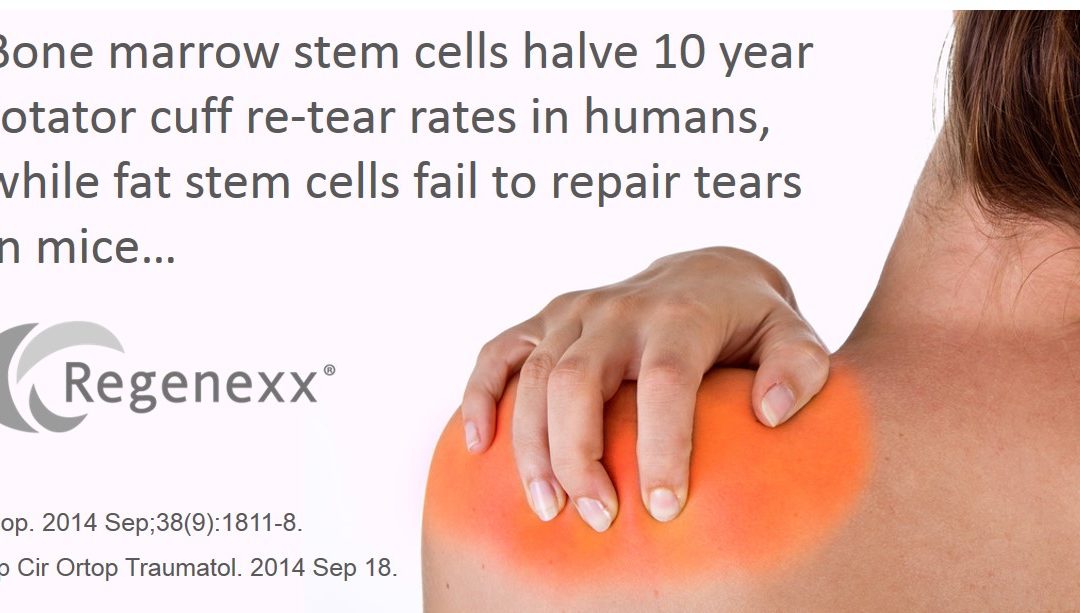One of the biggest debates in the stem cell field right now is over the role of adipose stem cells versus their cousins derived from bone marrow. While bone marrow stem cells have been used extensively for orthopedic injuries going back to the 1990s, adipose stem cells have only been used to any significant degree in the last few years. Having said that, we all have a little extra around our mid-sections that we can donate to harvest stem cells, right? However, one issue with fat derived stem cells is that they haven’t been shown to be as helpful for orthopedic diseases in head to head lab tests with bone marrow. Now a new animal study continues that trend by showing that they failed at helping shoulder rotator cuff injuries heal.
The rotator cuff is a series of muscles around the shoulder that stabilize the joint through movement. Tears can be notoriously hard to fix surgically, as many patients with tears lack a good rotator cuff blood supply or adequate local stem cells to aide healing. As a result, shoulder rotator cuff re-tear rates after surgical repair are high. Recently a large 10 year case series was published out of Europe that demonstrated that bone marrow stem cells could halve the retear rate of shoulder rotator cuff repairs. This wasn’t in rats, but in real human patients.
Adipose stem cells are cousins to bone marrow stem cells. While the former lives in your fat deposits, the latter lives inside the bone marrow. Largely because of America’s interest in liposuction, many plastic surgeons and others have begun to digest the fat from liposuction procedures to release the stem cells trapped in the collagen. Regrettably for U.S. doctors, the FDA has declared this medical procedure a drug, meaning that any physician performing the procedure is floating some regulatory risk. Having said that, the procedure itself is rapidly spreading. Proponents of fat stem cells have argued that there are simply more stem cells in fat, while proponents of bone marrow stem cells have argued that there’s more research on this stem cell type and obtaining a bone marrow sample is actually far less invasive than the violence of liposuction.
On the research side of things, there are hundreds of bone marrow studies focused on healing orthopedic tissues for every one on fat stem cells. This most recent research tried to fill that void by using fat stem cells to heal torn rotator cuff muscles in mice. After creating and surgically repairing rotator cuff tears, the animals were treated with either a control, fibrin glue, or their own stem cells plus fibrin glue. The fat stem cell group showed no better repair strength after 2 months of healing than the group who didn’t receive stem cells. The only advantage the fat stem cells could apparently muster was less inflammation, which is consistent with what we know about fat stem cells-they’re potent anti-inflammatory cells (which is what makes them so good for other diseases like MS).
The upshot? This study illustrates a good point in the dilemma facing many patients today with orthopedic problems who are researching whether to get a fat or bone marrow stem cell procedure. On the one hand, the allure of getting a “two for” treatment by loosing a bit of the love handles while also having a “stem cell” treatment is intoxicating. In addition, the sales point that there are so many stem cells in fat sounds compelling. Having said that, here we have a clinical problem that shows that the state of the art in fat stem treatment for rotator cuff tears is still in it’s infancy (in a research lab with mice), while for bone marrow stem cells we have a 10 year follow-up in real human patients. In addition, because fat stem cells aren’t ideal for orthopedic uses outside of their anti-inflammatory properties, the mouse model for fat stem cells shoulder treatment failed to show that they can help heal rotator cuff tears, while the 10 year human research shows “home run” type results. The take home message? Fat stem cells and bone marrow stem cells are at best distant cousins, while they sound like the same thing because both use the moniker “stem cell”, they’re quite different in what they can do to heal tendons, ligaments cartilage, and bone.
See Original post here: http://www.regenexx.com/2014/10/fat-stem-cells-shoulder/

